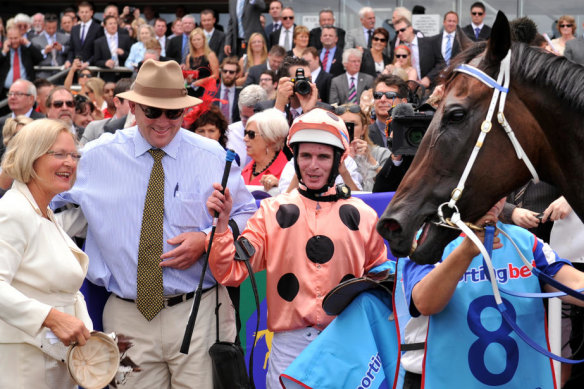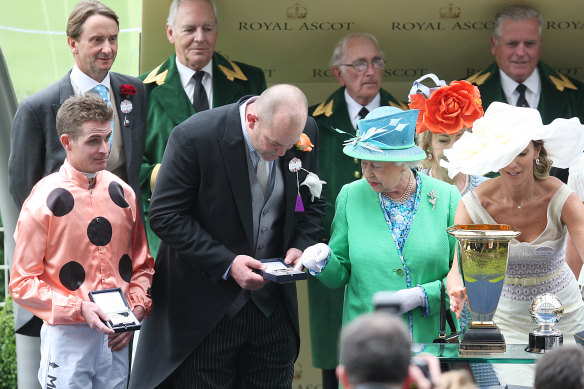
They watched as race day crowds grew, filled with people waving pink flags and wearing salmon and black polka dot hats. Some of them had never been to the track before.
“You become a lot more known outside the sport for sure,” Moody said.
“At the time it was akin to being the premiership-winning captain here in Melbourne. Every bastard knew you, and everyone wanted a slice of you. You got invited to the opening of an envelope. You are an A-lister for a few years.”
Being front and centre wasn’t Moody’s thing. He didn’t like the growing attention nor the accompanying pressure.
“When she won her 13th race in Brisbane I actually stupidly said to Sarah my wife, ‘I can’t wait for her to get beat so it just becomes normal’,” he said.
“What a stupid thing to say, because it had built up that much. But that was where the pressure level was.
“I had taken her back to Queensland to showcase her to my home state, which is where I was born and raised – I have lived in Victoria a lot longer than I have lived in Queensland probably – but I took her back there, thinking, ‘well, this will be a nice relaxing trip’.”
Black Caviar was a big-striding mare who dominated fields from the front. She looked to be loping while the rest of the field was busting a gut.
Black Caviar dominated races from 1000m to 1400m in Victoria, NSW, Queensland and South Australia. She won almost $8 million in prize money.
But it was the night she took on the world at Royal Ascot in 2012 that she became the horse that stopped the nation.

Peter Moody with Black Caviar’s connections at Caulfield.Credit: Vince Caligiuri
People flocked to Melbourne’s Federation Square in the middle of the night to watch her race.
It had been quite the lead-up, the champion transported to England by plane in a specially designed compression suit that rivalled Cathy Freeman’s Sydney Olympic outfit for its audacity.
Black Caviar held on to win the Diamond Jubilee at Royal Ascot by a heart-stopping nose, and the Federation Square crowd went wild as Moody and his wonder horse were taken to meet the Queen.
“For me going to the UK a couple of times and being beaten, to win that race at Royal Ascot was special,” Moody said.

What a moment: Peter Moody next to Queen Elizabeth at Royal Ascot.Credit: Julian Andrews
“But the sad thing about that was, she was a long way off her top. And people focused on Luke’s ride instead of the fact that he was trying to look after her because he knew what was under him, and he knew she wasn’t right.
“But to win that race, in honour of the Queen, at the Queen’s own racetrack, and to have her in attendance, I am a long way from a royalist, but it was hard not to be a special moment as well.”
Moody said he was quite emotional on Saturday morning when the news filtered through, but the hardest part was telling people who had worked with Black Caviar in the years she was at his stable between 2009 and 2013.
“I told my family, knowing she was in a bit of trouble and knowing that she might struggle to survive,” Moody said.
“But then making that phone call to Tony Haydon, and Paddy Bell, and Donna Fisher and Mick Bryant and Peter Angus, my vets, my farrier Matty Martin, you know, people who really that had an attachment to her and worked on her each and every day.
“To have to tell them, you know, that was probably as hard and as emotional as anything because I knew she had touched a lot of people’s lives, particularly the people who were hands-on.”
When pressed to name Black Caviar’s greatest or most memorable win, Moody couldn’t say.
“Her first two races were just out of this world,” he said. “But from that day onwards, each and every one of them held something special because she sort of sustained or carried ailments from that point onwards, and we really didn’t know if we were going to get to see how good she was.
“Because every run from run three onwards was her last if something went wrong again.”



























